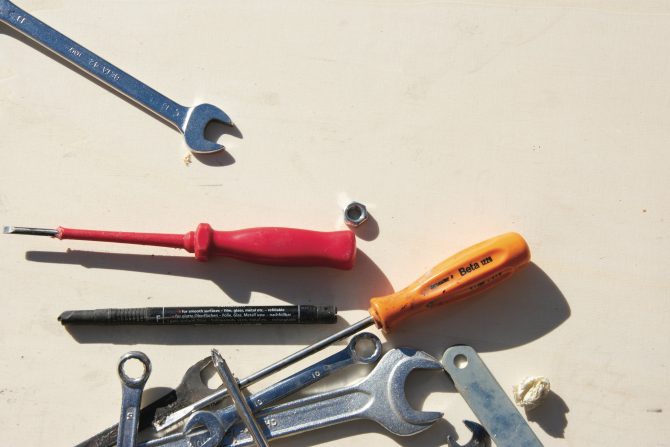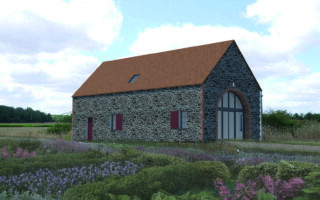Materials for an Old House


Old French properties have no damp proof course and were designed to ‘breathe’ – ie: to allow moisture to be absorbed by the walls in damp weather and to evaporate in dry weather, thus reducing condensation and the formation of mould.
To facilitate this process, you must use traditional and natural materials and products such as lime-based mortar, rendering and plaster, and chalk and limewash paints – with matt rather than gloss finishes. Non-porous mortar or cement, plaster and vinyl and acrylic paints will prevent evaporation, trapping moisture inside the walls and causing them to degenerate; condensation on the inside surface will make the building more difficult to heat and eventually unhealthy. Sealants applied to floor tiles or flagstones and the use of lino or thick carpet will have a similar effect.
Don’t use cement or artificial lime products or ready-to-use mortar on a house built of stone, brick or cob. Only natural lime products (la chaux naturelle or la chaux naturelle hydraulique) should be used, identifiable by the European standard designations CL, DL or NHL printed on the bags. If you’re having work done by professionals, you should insist on the use of such products and check that they’re being used (and that they’re specified in the quote you receive).
Making your own slaked lime (la chaux éteinte) to use in mortar and rendering can save you money, but certain precautions must be taken. You must buy quick (or burnt) lime (la chaux vive), which is sold in bags by agricultural co-operatives and is a fraction of the price of slaked lime, and ‘slake’ it. (In doing so, you will be re-enacting a procedure that dates back to Roman times!) The procedure is to two-thirds fill a metal bucket (never use a plastic container!) with water and pour the lime into it. Leave it for 24 hours to cool and stir with a spade or stick.
Quick lime is a dangerous substance and you must wear appropriate protective clothing, including gloves, mask and goggles. When mixed with water, quick lime boils spectacularly and can reach a temperature of 180ºC (equivalent to a hot oven!).
The resulting slaked lime, which should be a firm paste, will keep for months provided that it’s kept underwater to prevent it from hardening.
There are three grades of sand: fine (fin, blanc or jaune), for cement (maçonner) and coarse (ordinaire or gris). Sand is cheapest from a sablier (look under Sables, cailloux et granulats in the yellow pages). Medium grade sand collected costs around E20 per m3 (approximately 1.5 tonnes); if you want it delivered, there’s usually a minimum quantity, e.g. 10m3, plus a delivery charge that depends on how far your property is from the depot. Builders’ merchants usually sell sand, but the cost may be higher (e.g. €30 per m3). A cheaper alternative is le sable reconstitué or le sable noir, which is recycled crushed concrete; it’s rather coarse and more difficult to use than proper sand but is just as good for most uses.
If your property is located near the sea and you find yourself tempted to use sand from the beach for your mortar and rendering, don’t! The salt in the sand will prevent it from drying properly; beach sand must be left in the rain for at least a year before use in order for all the salt to be washed out. Sand from sand dunes, on the other hand, can be used – if you’re permitted to remove it.
A relatively new material – or rather an adaptation of a traditional material – used in construction is hemp (le chanvre; the material used in construction being called la chènevotte), which has good insulating properties and costs roughly the same as ‘conventional’ insulating materials. Further information about hemp can be obtained from the Fédération Nationale des Producteurs de Chanvre, 20, rue Paul Ligueul, 72000 Le Mans (02 43 28 99 23).
Tools
An essential tool for working on an old house with thick stone walls is a heavy-duty drill (un perforateur). A cordless combined drill and screwdriver is also a must for fixing plasterboard, etc., and a circular saw (une scie circulaire) and a small angle grinder (une meuleuse) are useful. In the last two cases, it’s often best to buy the cheapest available and replace them when they break! Scaffolding is useful both inside and out. Large and expensive items, such as compressors (un compresseur) and industrial sanders (une ponceuse industrielle), can be hired (see below).
Tool and equipment hire
Most DIY superstores have hire services (la location), although hiring isn’t as common as in some other countries. If you’re hiring tools or equipment, thorough preparation is essential to make sure that you can complete the job within the hire period; for example, you must ensure that you buy all the required materials (and enough of them!) and that any preliminary work, such as stripping and cleaning surfaces, is done well in advance.
Buying new
Most DIY superstores accept credit cards and have plenty of knowledgeable staff (unlike their counterparts in some other countries). There’s usually a specialist in each department (un rayon), and you should always ask for the chef de rayon when seeking advice.
Some retailers (eg: Leroy Merlin) provide a ‘consultancy’ service, whereby a member of staff will visit your property and calculate your requirements, eg: for insulation material, flooring and plasterboard, and give you a quotation including delivery, which may be negotiable depending on the amount you’re spending.
As in other countries, chain stores often have their own brand of economy products, which may be just as good as more expensive alternatives. Take advantage of the January and August sales, when you can pick up bargains, and look out for promotions; even if something appears not to be on offer, it’s worthwhile asking, as offers aren’t always advertised. However, you should always consider the type of work to be undertaken and whether or not savings will be justified in terms of quality and availability. Saving money on end-of-range products such as paint or wallpaper can be ill-advised unless you’re absolutely sure of the quantity required for a job.
Ask your neighbours where to buy fittings and materials, as they usually know the best places locally. If there isn’t a superstore nearby, most towns have a hardware shop (une quincaillerie) selling tools and materials, where prices aren’t always higher than in a DIY supermarket and, of course, you can establish a relationship with the owner if you buy from him regularly and may also be able to establish an account.
Sadly, small producers of building materials, such as bricks and tiles, as well as local sawmills and quarries are becoming hard to find, so you may need to do a little detective work to track down ‘authentic’ materials. Similarly, although France has many outlets for secondhand and reclaimed materials, these aren’t always easy to find. Note also the following:
* There are no ‘trade only’ suppliers in France, and you can buy products from the same specialist shops as professional tradesmen, although tradesmen might pay less.
* Doors, windows and other woodwork items can be found in chain stores (Lapeyre specialises in menuiserie), but often a local carpenter (un menuisier) will make them just as cheaply – and to exactly the required dimensions.
* Most shops will deliver material, and the larger outlets usually rent self-drive vans if you buy large or heavy items from them.
Taken from Renovating and Maintaining Your French Home by Joe Laredo, Survival Books. This book is available from the French Entrée bookshop.
Share to: Facebook Twitter LinkedIn Email
More in beach, courses, heating, renovation, shops, work
By FrenchEntrée
Leave a reply
Your email address will not be published. Required fields are marked *




REPLY
REPLY